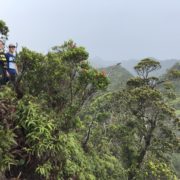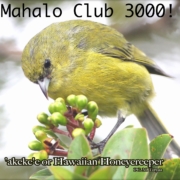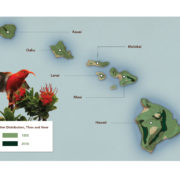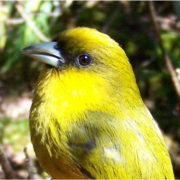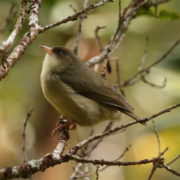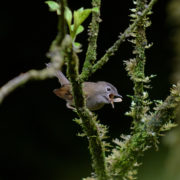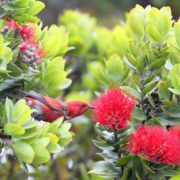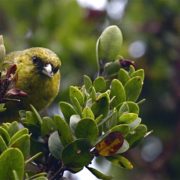Club 300 for bird protection partially funds mosquito control project on Kaua’i
/in Blog, News/by Julia DiegmannHawai’i is the endangered species capital of the world, yet conservation here is woefully under-funded. Over 63% of forest bird species have become extinct (71 different species) across the islands. On Kaua’i, five of 13 forest birds have disappeared in the last 40 years. Three of the remaining eight species are listed as Endangered (Akikiki – 468; birds; Puaiohi – 494 birds; Akekee – 945 birds;). A fourth is listed as Threatened (Iiwi, 2500 birds on Kaua’i).
The project aims to address mosquito-borne diseases and reduce mosquito breeding habitat caused by weeds. Climate change models show forest bird species are in increased danger due to the movement of disease-carrying mosquitoes into high- elevation refugia. The impacts of this work cannot be overstated, as it will help avert the imminent extinction of at least two species.
Mahalo to the Club 300 of bird protection for providing funds to carry out this important work on Kaua’i.
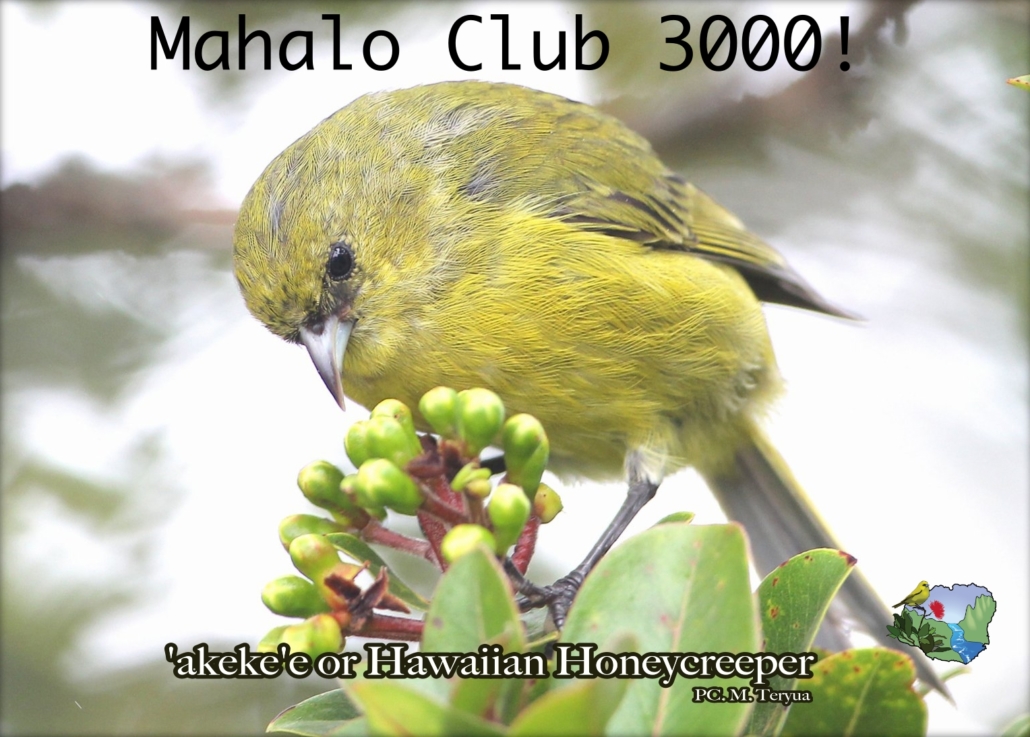
Cornell Lab is Keeping Hope Alive For Hawaiʻi’s ʻIʻiwi
/in News/by MonikaIn this article published in All About Birds, by the Cornell Lab of Ornithology, author Kim Steutermann Rogers ponders the rapid decline in ʻIʻiwi populations and the obstacles they face including: diseases, mosquitos, climate change, habitat destruction, and Rapid ʻŌhia Death. However, it’s not all doom and gloom for the ʻIʻiwi. She wraps up the article by discussing optimism for the crimson honeycreeper as new scientific breakthroughs become available to decimate mosquito populations. You can learn more about the ʻIʻiwi and this new technology by reading the full article here.
Celebrating Hawaii’s Birds – The ABA says aloha to the Akikiki, Oreomystis bairdi
/in News/by Julia DiegmannRead more about the Akikiki in the current issue of the ABA Birding Magazine:
In this issue, we continue a year-long ABA aloha to the remarkable avifauna of Hawaii. We kicked off the series in the February issue, with ABA president Jeffrey A. Gordon’s tribute to the 2018 Bird of the Year, the Iiwi. In this issue, Hawaiian ornithologists Lisa Crampton and Helen Raine lead us in an apprecia- tion of the critically endangered Akikiki—subtle in appearance, but striking in behavior and ecology.
The Akikiki is Hawaii’s answer to a nuthatch, hang- ing upside down and contorting itself into knots to chase down insects and spiders among bark, li- chens, and mosses. Found only on the island of Kauai, the bird is actually a Hawaiian honeycreeper. It doesn’t have the showy plumage of other natives, such as the crimson Iiwi, but the Akikiki quickly becomes a favor- ite of birdwatchers, as it rockets up tree trunks after invertebrates or performs elaborate courtship dances.
Find the full article here: Crampton & Raine!
The Kaua’i Forest Bird Recovery Project thanks all our partners: Hawaii Division of Forestry and Wildlife, US Fish and Wildlife Service, University of Hawaii, PCSU, San Diego Zoo Global, American Bird Conservancy, National Fish and Wildlife Federation, United States Geological Service, The Nature Conservancy, Kokee Resource Conservation Program, and Garden Island Resource Conservation and Development, and Mohamed bin Zayed Conservation Fund, among others.
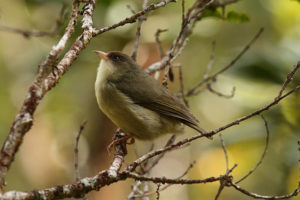
‘Akikiki- Photo by Patrick Blake
New Study Reveals Just How Important Native Birds are to the Forest
/in Blog, News/by Monika A recently published study from the heart of Kauaʻi’s Alakaʻi Wilderness Preserve has revealed that Puaiohi, a critically endangered native thrush, plays a key role in keeping the rainforest healthy. This delicately patterned songbird eats native fruits and disperses their seeds, but it is estimated that there are fewer than 500 birds left in the wild. Researchers with the Kauai Forest Bird Recovery Project (KFBRP) looked at whether the introduced Japanese White-eye can fill this niche but found that White-eyes prefer smaller seeds and are also spreading invasive plants.
A recently published study from the heart of Kauaʻi’s Alakaʻi Wilderness Preserve has revealed that Puaiohi, a critically endangered native thrush, plays a key role in keeping the rainforest healthy. This delicately patterned songbird eats native fruits and disperses their seeds, but it is estimated that there are fewer than 500 birds left in the wild. Researchers with the Kauai Forest Bird Recovery Project (KFBRP) looked at whether the introduced Japanese White-eye can fill this niche but found that White-eyes prefer smaller seeds and are also spreading invasive plants.
KFBRP Project Coordinator, Dr. Lisa Crampton, said, “Kauaʻi has experienced extinction and catastrophic declines in fruit-eating native bird species, combined with the introduction of non-native species. Our results underscore how important it is to protect Puaiohi if we want preserve Kauaʻi’s montane ecosystem. This is the only native songbird capable of dispersing larger seeds in the rainforest”.
The study was led by Dr. Monica Kaushik, a Fulbright Fellow at Colorado State University (CSU), in collaboration with KFBRP and Dr. Liba Pejchar of CSU. Kaushik was surprised to find that sites with Puaiohi received substantially higher ‘seed rain’ (number of seeds caught in seed traps) even though fruit abundance was the same. She says, “Non-native birds cannot adequately replace the seed dispersal services provided by Puaiohi. If Puaiohi continue to be rare and their range is restricted, we’re likely to see important changes in the plant community, such as increased numbers of invasive or small-seeded plants. Other native plants might fail to regenerate altogether”.
Kauaʻi has lost five of its native birds in recent decades and those that survive are restricted to a small area of pristine forest at higher elevations. They are at risk from introduced predators, such as rats and feral cats, avian malaria, and habitat destruction.
This latest study adds to the body of evidence showing that the loss of native birds jeopardizes the fate of native plants. This has consequences for people as the forest provides humans with free ecosystem services such as flood water attenuation, filtration, and fertilization for fields downstream.
Co-author Dr. Liba Pejchar agrees: “KFBRP works hard to protect Kauai’s forest birds despite a perfect storm of disease, invasive predators, and limited resources to address these challenges; our results reinforce the critical importance of their efforts not only for the birds, but also for Kauai’s diverse and beautiful rainforest”.
You can read the full study here. The Garden Island Newspaper also covered this story.
SaveSave
NY Times Poses a Tough Question about the Fate of Hawaiiʻs Forest Birds
/in News/by MonikaA recent article in the New York Times Magazine poses the question, “Should some species be allowed to die out?
It is our mission at the Kauai Forest Bird Recovery Project to no let this happen.
Should We Consider Translocating Kaua‘i Forest Birds?
/in News/by MonikaFor Kauai Online explores whether we should consider translocating Kauaʻi forest birds in this article by Ruby Pap.
The full report entitled, Assessing the potential of translocating vulnerable forest birds by searching for novel and enduring climatic ranges by Lucas B. Fortini, Lauren R. Kaiser, Adam E. Vorsino, Eben H. Paxton, and James D. Jacobi, can be viewed here.



